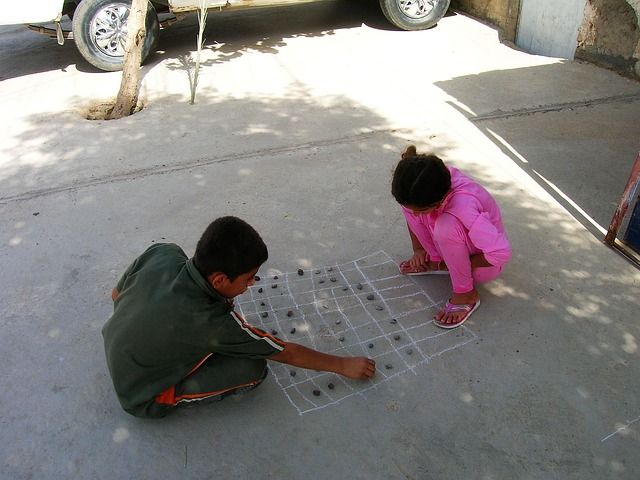[dt_button link=”http://d165vjqq8ey7jy.cloudfront.net/mp3/33270/se-8131s.mp3″ target_blank=”true” button_alignment=”default” animation=”fadeIn” size=”small” style=”default” bg_color_style=”custom” bg_color=”#333333″ bg_hover_color_style=”custom” bg_hover_color=”#444444″ text_color_style=”custom” text_color=”#ffffff” text_hover_color_style=”custom” text_hover_color=”#dddddd” icon=”fa fa-cloud-download” icon_align=”left”]Yuklash[/dt_button]
[dt_divider style=”thin” /]
Transcript:
Voice 1
Welcome to Spotlight. I’m Liz Waid.
Voice 2
And I’m Bruce Gulland. Spotlight uses a special English method of broadcasting. It is easier for people to understand, no matter where in the world they live.
Voice 1
The children laugh and shout loudly. They are playing games in the playground. One child is “it”. He runs after a group of other children. He catches one of them. That second child becomes ‘it’. She now chases the other children and tries to catch one. They are all playing a game of chase or tag.
Voice 2
In another area of the playground, two children each hold opposite ends of a long rope. They turn it round and round and up and down. Other children take turns to jump over the rope as it is being turned. They are skipping. And all the children who are skipping are also singing special skipping songs.
Voice 1
Children in all parts of the world play similar games. Many generations of children have enjoyed playing these traditional games. But could these games have a more important purpose? Today’s Spotlight is on traditional children’s playground games.
Voice 2
Experts everywhere agree that play is good for children. They say it is important for a child’s mental and physical development. Nicola Butler from the organisation Play England told the Huffington Post,
Voice 3
‘Traditional playground games are necessary for children’s health, wellbeing and development. Playing these games lets children learn about friendships. They learn about arguing, making up, negotiating and resolving disputes, and making the game fun and fair. But most importantly being involved in these games make children happy.’
Voice 1
Did you know that children from many countries play the same or similar traditional games? Though, these games often have different names in different countries. The game of leapfrog has been played in the United Kingdom since the 16th century. In this game, one child bends down and holds his knees or ankles. Another child runs up to the first child, places her hands on the back of the first child, and leaps or jumps over the first child. Any number of children can play the game. They all take turns to leap, or jump, like a frog. In other countries children jump like a different animal. In France children call this same game ‘sauté-mouton’ which means ‘leap sheep’. In India they call it ‘Aar Ghodi Ki Par Ghodi’ which means ‘leap horse’.
Voice 2
Another game children play all over the world is hopscotch. In Albania they call the game varra. In Germany it is hinkspiel. Yohanes Lie told TOPICS Online magazine what the game is called in his country,
Voice 4
‘When I was a child, my friends and I used to play many traditional games from my country, Indonesia. A game I played a lot was called One Leg Jump.’
Voice 1
‘One leg jump’ is a good name for the game of hopscotch. That is because the name ‘one leg jump’ helps you understand how to play the game! The players mark squares on the ground using a stone or piece of chalk. Children in different parts of the world make different shapes or grids with the squares. But some things are always the same. The children all hop or jump on one leg from square to square. And they must not put a foot on any line.
Voice 2
Very often, children play the game using a stone. They throw the stone onto square one and take their turn hopping on the whole grid. They hop to the last square. Then they turn round and hop back. On their next turn they will throw their stone onto square two. And on their next turn they throw on to square three and so on. If the stone does not land in the correct square, the child must lose a turn. Maria Lopez from Columbia told TOPICS how she enjoyed playing hopscotch when she was a child,
Voice 5
‘When I was a little girl, most afternoons I used to play games with my friends in our street. Rayuela, as hopscotch is called in Spanish, was my favourite game. It is nice to remember playing games like Rayuela because it shows me that I had a happy time as a child surrounded by special people who always loved me.’
Voice 1
It may surprise you to learn that hopscotch is a very old game. Experts say that nearly 2000 years ago, Roman soldiers used something similar as an exercise. They had to hop up and down a 100 foot series of squares. They did this to make them stronger and quicker on their feet.
Voice 2
Marbles is another ancient game that is played around the world. No one knows exactly how old it is. But we know the Romans played this game too. You can see children playing marbles on ancient Roman wall paintings.
Voice 1
But what are marbles? And how do you play the game of marbles? Marbles are very small hard balls. You can find marbles made from different sorts of stone, including the stone called ‘marble’. But most marbles are made from brightly coloured glass. People play many different sorts of games with their marbles. But all of these games are called simply ‘marbles’.
Voice 2
‘The Ring Game’ is one popular game of marbles. A child uses a stone or chalk to make a circle or ring on the ground. Those playing the game put a few of their marbles into the ring. Each child rolls or shoots another marble to try to push one of the marbles out of the ring. If a player manages to do this he keeps that marble. Hakan Tuncer, from Turkey, played marbles as child. But he used a triangle shape – not a circle. He told TOPICS how he and his friends would compete for marbles,
Voice 6
‘I think the most important thing was to have as many marbles as we could. We competed to win the most marbles. The person who won the most marbles was the leader of the group. And everyone tried to be the leader. Now I understand that this small competition was our first experience with power and leadership.’
Voice 1
Traditional playground games are about more than just fun. Hopefully children continue to learn these games and their valuable lessons for hundreds more years.
Voice 2
Do you remember playing traditional playground games when you were a child? Tell us about playground games in your country. You can leave a comment on our website. Or email us at radio@radioenglish.net. You can also comment on Facebook at Facebook.com/spotlightradio.
Voice 1
The writer of this programme was Katy Blake. The producer was Michio Ozaki. The voices you heard were from the United States and the United Kingdom. All quotes were adapted for this programme and voiced by Spotlight. You can listen to this programme again, and read it, on the internet at www.radioenglish.net. This programme is called ‘Traditional Children’s Games.’
Voice 2
Look for our free listening app in the Google Play Store and in iTunes. We hope you can join us again for the next Spotlight programme. Goodbye.




